Routine Production of 89Zr Using an Automated Module
Abstract
:1. Introduction
| Nuclear Decay: | Simplified decay scheme: | |
|---|---|---|
| Half-life, t1/2 | 3.27 days |  |
| Daughter isotope | 100% 89Y (stable) | |
| Decay modes | 23% β+ | |
| 77% EC | ||
| β+ energy, Eβ+, avg (range in water) | 396 keV (1.2 mm) | |
| γ-ray energy, Eγ (intensity) | 909 keV (99.0%) | |
| Gamma factor, Γ15 keV | 6.6 R∙cm2∙mCi−1∙h−1 | |
| Theoretical specific activity | 40 Ci∙μmol−1 | |
| Metastable isomer(s) | 89mZr |
| Target (natural abundance) | natY (100% 89Y) |
| Production reaction | (p,n)89Zr (t1/2 = 3.27 days) |
| Peak cross-section and energy, σ (Eβ+) | ~0.8 b (~15 MeV) |
| Reaction threshold, Q | 3.7 MeV |
| Stopping range of 14.7 MeV protons | 1.02 mm |
| Other possible reactions | (p,n)89mZr (t1/2 = 4.2 m) |
| (p,2n)88Zr (t1/2 = 83.4 days) | |
| (p,pn)88Y (t1/2 = 107 days) | |
| Optimum beam energy, Ep | 13 MeV |
| Target preparation | hot-rolled natY metal foil |
2. Experimental Section
2.1. Materials
2.2. Cyclotron Production

2.3. Separation Chemistry
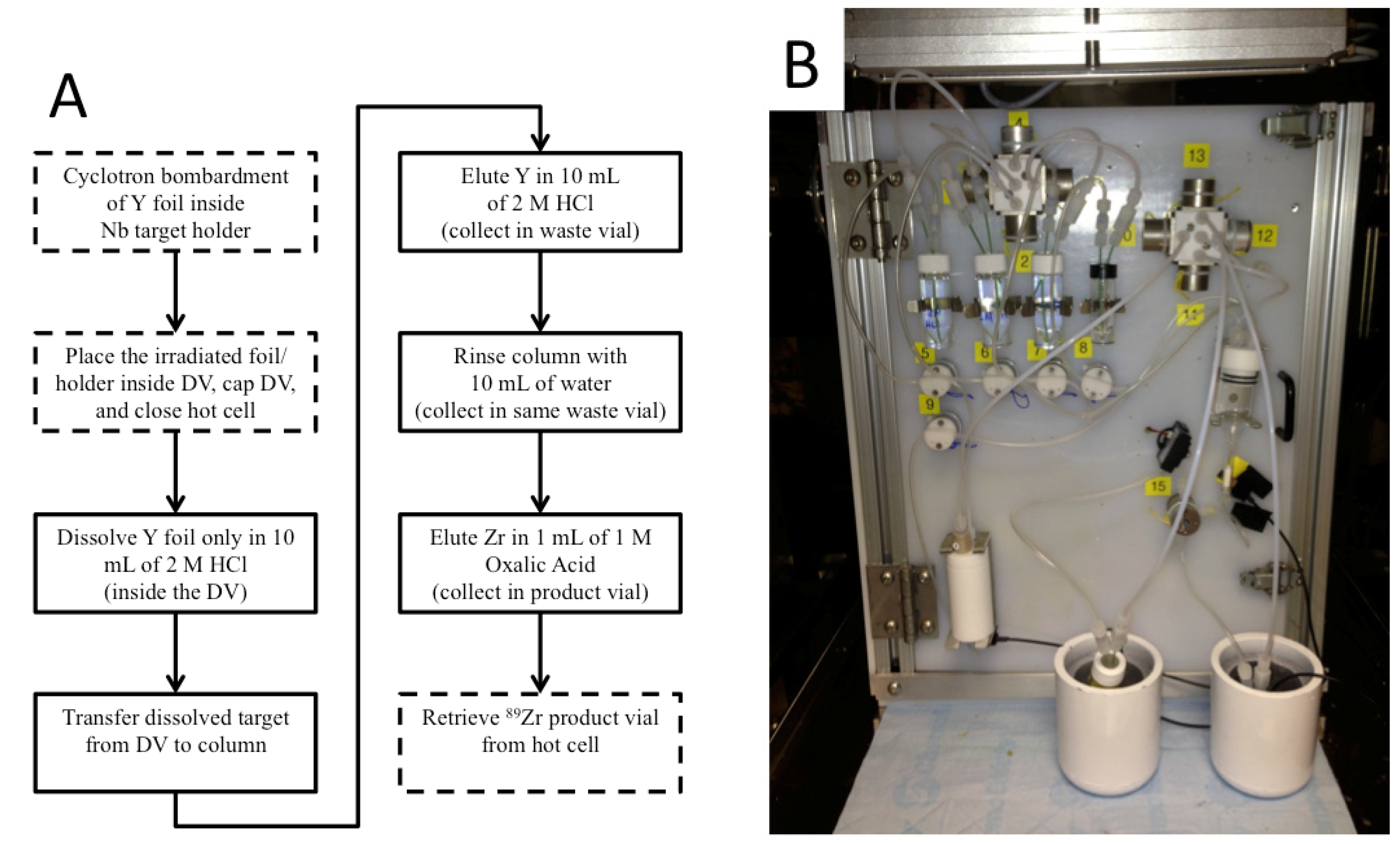
2.4. Automated Module
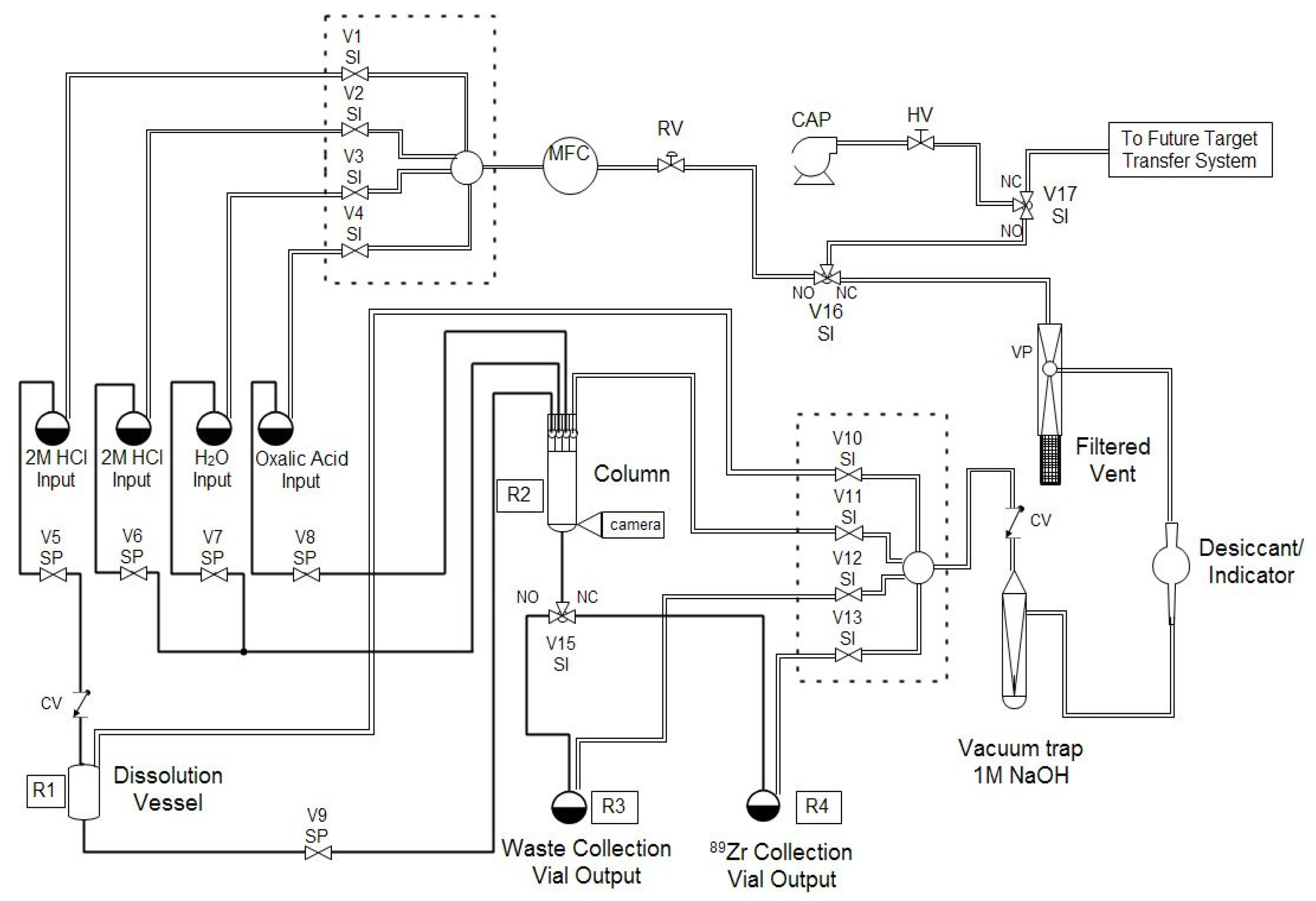
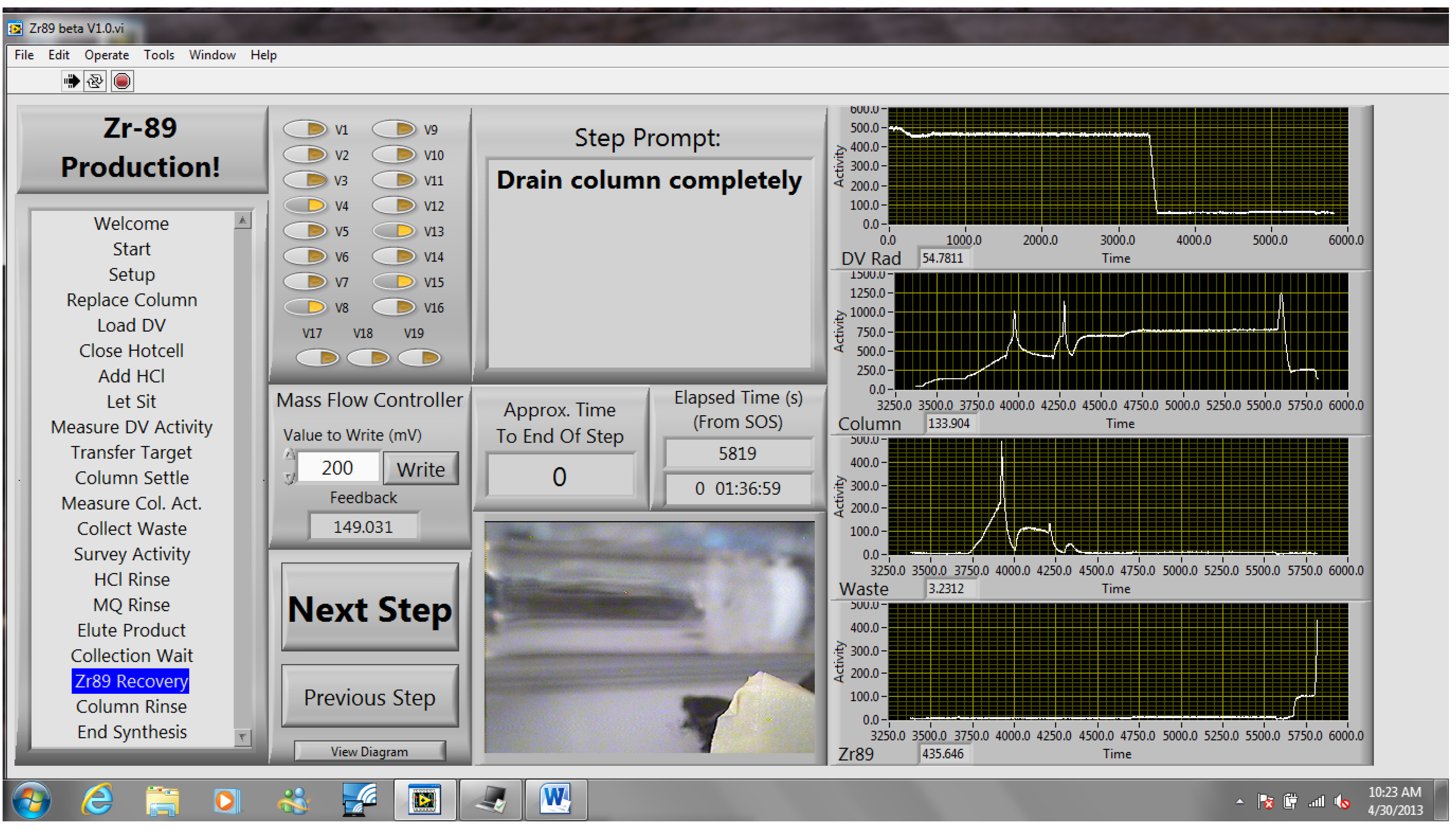
2.5. Product Characterization
3. Results and Discussion
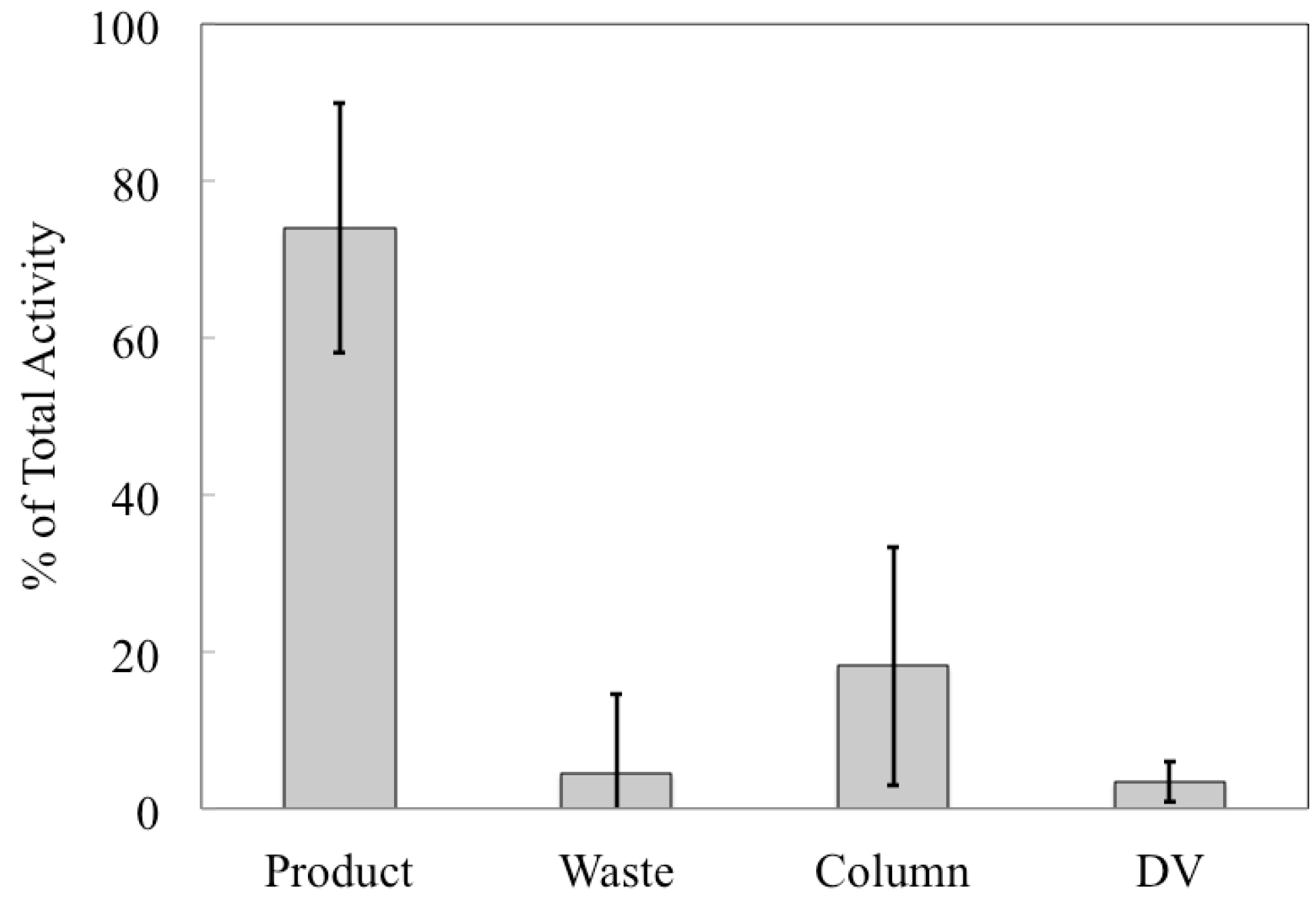
| Bombardment Time | Predicted Activityfrom Cyclotron | Estimated Total Activity | Effective Specific Activity |
|---|---|---|---|
| h (μA∙h) | mCi | mCi (% of Predicted) | mCi∙μmol−1 (% of TSA) |
| 4 (60) | 79 | 62 (78%) | 353 (0.88%) |
| 2 (30) | 40 | 30 (74%) | 250 (0.63%) |
| 2 (30) | 40 | 30 (76%) | 134 (0.33%) |
| 2 (30) | 40 | 29 (74%) | 87 (0.22%) |
| 2 (30) | 40 | 27 (68%) | 73 (0.18%) |
| 2 (30) | 40 | 30 (75%) | 63 (0.16%) |
| 4 (60) | 79 | 37 (47%) | 59 (0.15%) |
| 2 (30) | 40 | 20 (50%) | 25 (0.06%) |
| 2 (30) | 40 | 29 (72%) | 21 (0.05%) |
| 1 (15) | 20 | 15 (75%) | 15 (0.04%) |
4. Conclusions
Acknowledgments
Conflict of Interest
Electronic Supplementary Information

| Y Foil Thickness | Bombardment Parameters | Target Holder Description | Target Cooling Description | Activity/ (μA × h) | % Recovery | Radionuclidic Purity | ESA | ||
|---|---|---|---|---|---|---|---|---|---|
| mm | μA × h | mCi/ (uA x h) | % of total activity | mCi∙μmol−1 (% of TSA) | |||||
| This Work | 2013 | 0.64 | 15 × 4 § = 60 | Machined Nb | Chilled water (2.2 °C); He jet (beam side) | 3.67-15 | 93% † | 99.998% | 5-353 (0.01%–0.88%) |
| Walther, et al. [20] | 2011 | 0.15 | 12 × 2 = 24 | Aluminum | Chilled water; He jet (beam side) | 0.338 | 97.5% | >95% | - |
| Dutta, et al. [21] | 2009 | 0.009 | 0.54 × 2.3 = 1.3 | - | - | - | - | - | - |
| Kandil, et al. [22] | 2007 | 13 (Y2O3 pellet diam.) | 2 × 5 = 10 | Covered with Al foil | Chilled water (13 °C) | 0.754 | 97.5% | 99.9% | - |
| Holland, et al. [23] | 2005 | 0.10 | 15 × 5 = 75 | 10° slant | Chilled water (25 °C) | 1.52 | 99.5% ‡ | 99.9% | 470-1195 (1.2%–3.0%) |
| Verel, et al. [24] | 2003 | 0.035 (sputtered) | 80 × 3 = 240 | onto Cu plate | - | 0.002 | 97% ‡ | 99.9% | - |
| Meijs, et al. [25] | 1994 | 0.025 (sputtered) | 100 × 1 = 100 | onto Cu plate | - | 0.069 | 98% ‡ | - | - |
| DeJesus and Nickles [26] | 1990 | 0.127 and 0.6 | 10 × 2 = 20 | - | Chilled water | 43 and 100 | 95% | 87% | - |
| Link, et al. [27] | 1986 | - | 10 × 0.66 = 6.7 | - | - | 10.51 | 25%–80% | 99% | - |

| Reaction | Product | Half-Life | Decay Mode(s) | Daughter (Yield%) | Gamma Ray Energyand Intensity | Radionuclidic Purity |
|---|---|---|---|---|---|---|
| t1/2 | Eγ keV (y%) | % of total activity(% of atoms) | ||||
| (p,n) | 89Zr | 3.3 days | 100% ε (77.3% EC, 22.7% β+) | 89Y(100%, stable) | 909 (99.0%) | 99.998% (99.95%) |
| 1713 (0.7%) | ||||||
| 1745 (0.1%) | ||||||
| (p,n) | 89mZr | 4.2 m | 93.8% IT, 6.2% ε (4.7% EC, 1.5% β+) | 89Zr(93.8%), 89Y(6.2%, stable) | 588 (89.6%) | Not Observed |
| 1507 (6.1%) | ||||||
| - | ||||||
| (p,2n) | 88Zr | 83.4 days | 100% ε (100% EC) | 88Y(100%) | 393 (97.3%) | 0.002% (0.05%) |
| - | ||||||
| - | ||||||
| (p,pn) | 88Y | 106.6 days | 100% ε (100% β+) | 88Sr(100%, stable) | 1836 (99.2%) | Not Observed |
| 898 (93.7%) | ||||||
| 2734 (0.7%) | ||||||
| TOTAL = | 100.00% |
| Product Vial | Waste Vial | Column | DissolutionVessel | EstimatedTotal Activity |
|---|---|---|---|---|
| mCi (%) | mCi (%) | mCi (%) | mCi (%) | mCi |
| 14.2 (97%) | 0.1 (0.5%) | 0.0 (0%) | 0.3 (2%) | 14.6 |
| 14.6 (93%) | 0.4 (2.5%) | 0.4 (2%) | 0.4 (2%) | 15.8 |
| 13.7 (84%) | 0.0 (0.0%) | 2.3 (14%) | 0.3 (2%) | 16.3 |
| 24.7 (84%) | 3.8 (12.9%) | 0.1 (0%) | 0.9 (3%) | 29.4 |
| 23.3 (82%) | 0.1 (0.3%) | 3.6 (13%) | 1.6 (5%) | 28.6 |
| 16.0 (79%) | 1.4 (6.9%) | 2.6 (13%) | 0.2 (1%) | 20.1 |
| 48.1 (78%) | 0.2 (0.2%) | 7.7 (12%) | 6.0 (10%) | 62.0 |
| 20.2 (74%) | 0.1 (0.3%) | 6.5 (24%) | 0.5 (2%) | 27.3 |
| 21.5 (71%) | 0.0 (0.1%) | 7.4 (24%) | 1.4 (5%) | 30.4 |
| 9.1 (61%) | 0.2 (1.2%) | 5.5 (36%) | 0.3 (2%) | 15.0 |
| 16.4 (56%) | 0.1 (0.5%) | 12.7 (43%) | 0.3 (1%) | 29.6 |
| 15.1 (50%) | 0.1 (0.3%) | 14.6 (48%) | 0.4 (1%) | 30.1 |
| 16.4 (44%) | 13.8 (37%) | 4.5 (12%) | 2.5 (7%) | 37.2 |
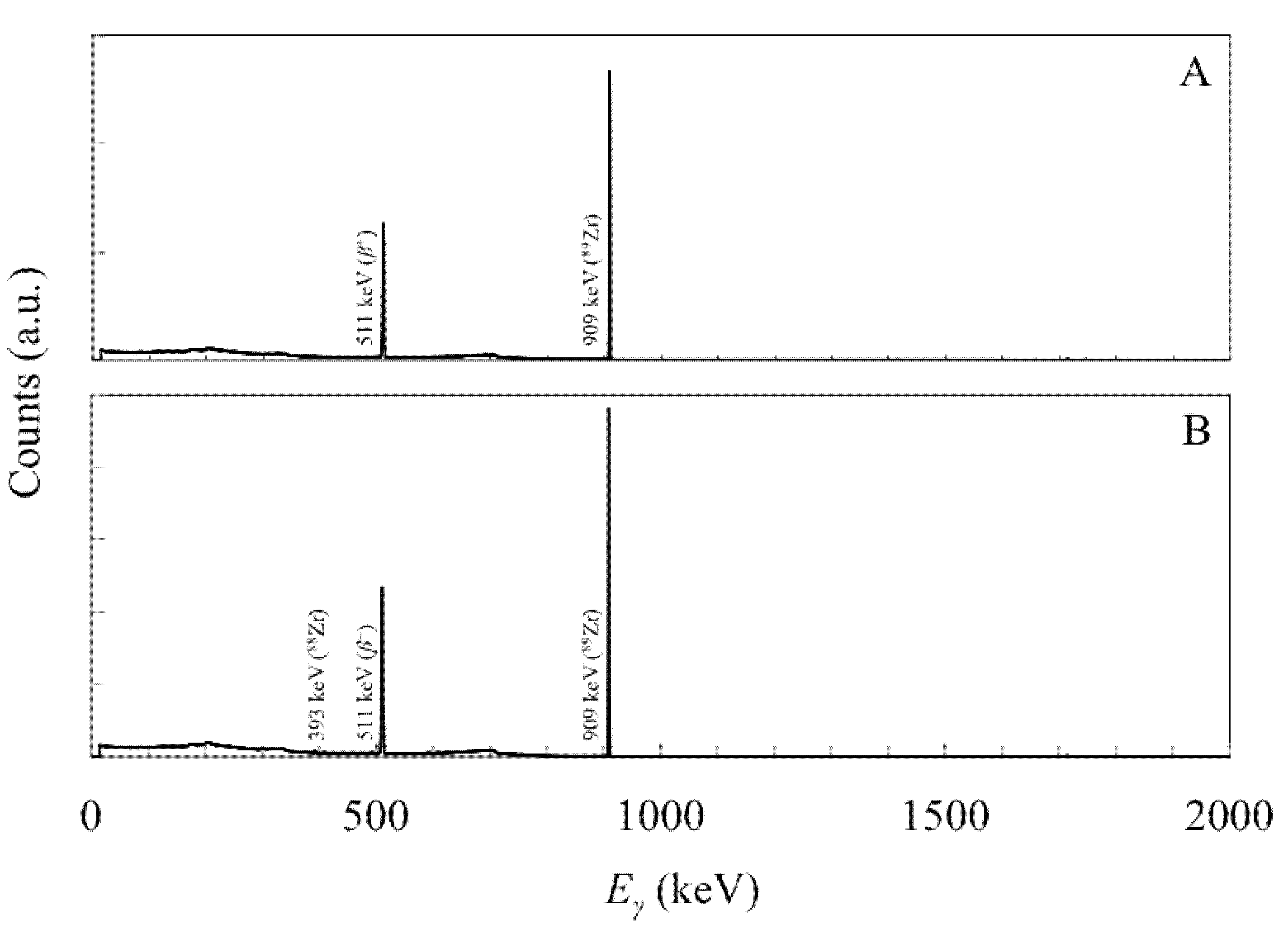
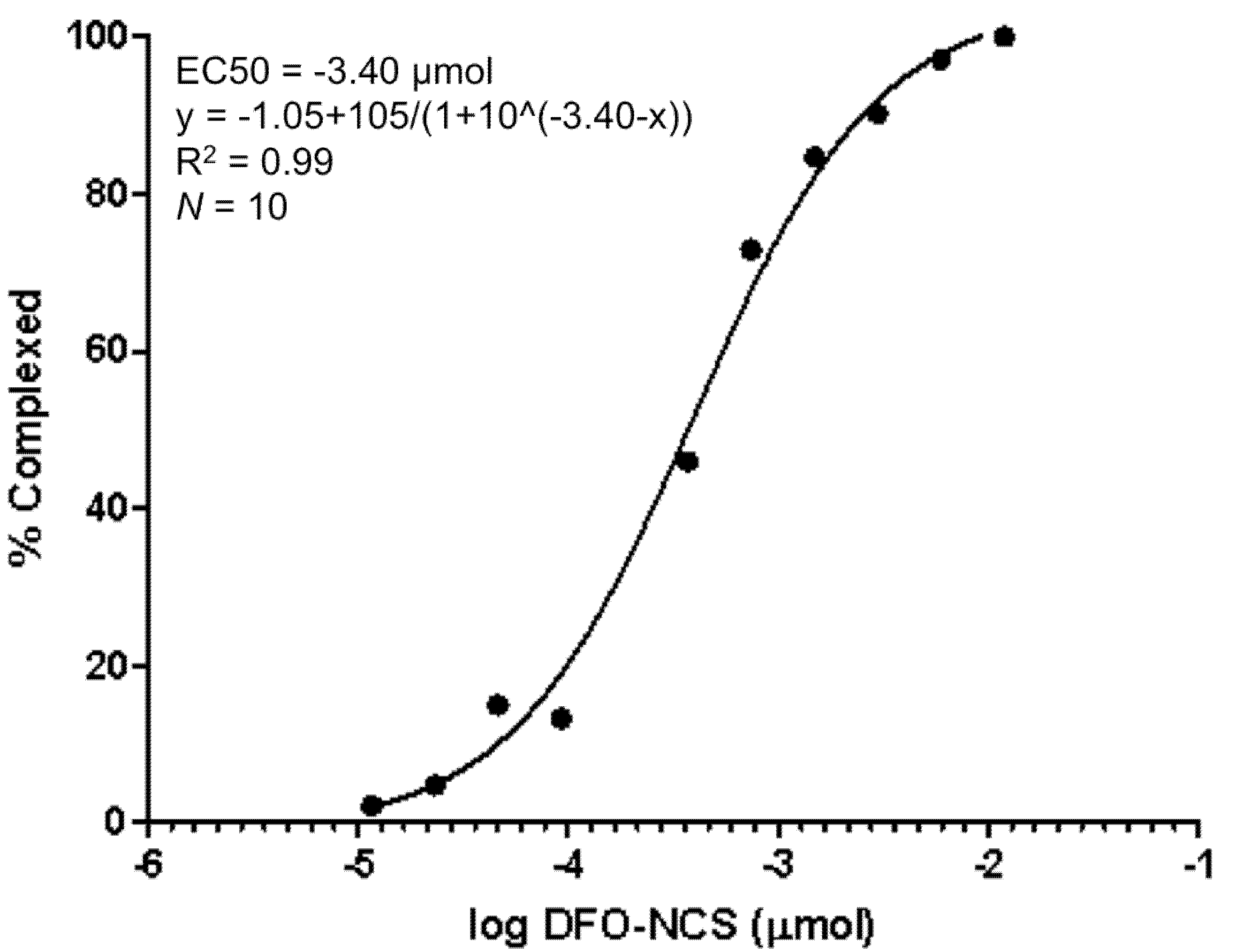
References
- Ikotun, O.F.; Lapi, S.E. The rise of metal radionuclides in medical imaging: Copper-64, Zirconium-89 and Yttrium-86. Future Med. Chem. 2011, 3, 599–621. [Google Scholar] [CrossRef]
- Wadas, T.J.; Wong, E.H.; Weisman, G.R.; Anderson, C.J. Coordinating radiometals of Copper, Gallium, Indium, Yttrium, and Zirconium for PET and SPECT imaging of disease. Chem. Rev. 2010, 110, 2858–2902. [Google Scholar] [CrossRef]
- Holland, J.P.; Williamson, M.J.; Lewis, J.S. Unconventional nuclides for radiopharmaceuticals. Mol. Imag. 2010, 9, 1–20. [Google Scholar]
- Nayak, T.K.; Brechbiel, M.W. Radioimmunoimaging with longer-lived positron-emitting radionuclides: Potentials and challenges. Bioconj. Chem. 2009, 20, 825–841. [Google Scholar] [CrossRef]
- Anderson, C.J.; Welch, M.J. Radiometal-labeled agents (non-technetium) for diagnostic imaging. Chem. Rev. 1999, 99, 2219–2234. [Google Scholar] [CrossRef]
- PubMed Online Database. Available online: http://www.ncbi.nlm.nih.gov/pubmed/ (accessed on 3 May 2013).
- Vugts, D.J.; Visser, G.W.M.; van Dongen, G.A.M.S. 89Zr-PET radiochemistry in the development and application of therapeutic monoclonal antibodies and other biologicals. Curr. Top. Med. Chem. 2013, 13, 446–457. [Google Scholar]
- Deri, M.A.; Zeglis, B.M.; Francesconi, L.C.; Lewis, J.S. PET imaging with 89Zr: From radiochemistry to the clinic. Nucl. Med. Biol. 2013, 40, 3–14. [Google Scholar] [CrossRef]
- Severin, G.W.; Engle, J.W.; Barnhart, T.E.; Nickles, R.J. 89Zr Radiochemistry for positron emission tomography. Med. Chem. 2011, 7, 389–394. [Google Scholar] [CrossRef]
- Zhang, Y.; Hong, H.; Cai, W. PET tracers based on Zirconium-89. Curr. Radiopharm. 2011, 4, 131–139. [Google Scholar] [CrossRef]
- McCabe, K.E.; Wu, A.M. Positive progress in immunoPET—Not just a coincidence. Cancer Biother. Radiopharm. 2010, 25, 253–261. [Google Scholar] [CrossRef]
- Van Dongen, G.A.M.S.; Vosjan, M.J.W.D. Immuno-positron emission tomography: Shedding light on clinical antibody therapy. Can. Biother. Radiopharm. 2010, 25, 375–385. [Google Scholar] [CrossRef]
- Van Dongen, G.A.M.S.; Visser, G.W.M.; Lub-de Hooge, M.N.; de Vries, E.G.; Perk, L.R. Immuno-PET: A navigator in monoclonal antibody development and applications. Oncologist 2007, 12, 1379–1389. [Google Scholar] [CrossRef]
- Verel, I.; Visser, G.W.M.; van Dongen, G.A.M.S. The promise of immuno-PET in radioimmunotherapy. J. Nucl. Med. 2005, 46, 164s–171s. [Google Scholar]
- Disselhorst, J.A.; Brom, M.; Laverman, P.; Slump, C.H.; Boerman, O.C.; Oyen, W.J.; Gotthardt, M.; Visser, E.P. Image-quality assessment for several positron emitters using the nema nu 4–2008 standards in the siemens inveon small-animal pet scanner. J. Nucl. Med. 2010, 51, 610–617. [Google Scholar] [CrossRef]
- Smith, D.S.; Stabin, M.G. Exposure rate constants and lead shielding values for over 1,100 radionuclides. Health Phys. 2012, 102, 271–291. [Google Scholar]
- Meijs, W.E.; Herscheid, J.D.M.; Haisma, H.J.; Pinedo, H.M. Evaluation of desferal as a bifunctional chelating agent for labeling antibodies with Zr-89. Appl. Radiat. Isot. 1992, 43, 1443–1447. [Google Scholar] [CrossRef]
- Kasbollah, A.; Eu, P.; Cowell, S.; Deb, P. Review on production of 89Zr in a medical cyclotron for PET radiopharmaceuticals. J. Nucl. Med. Technol. 2013, 41, 35–41. [Google Scholar] [CrossRef]
- National Nuclear Data Center (NNDC). Available online: http://www.nndc.bnl.gov (accessed on 4 July 2013).
- Walther, M.; Gebhardt, P.; Grosse-Gehling, P.; Würbach, L.; Irmler, I.; Preusche, S.; Khalid, M.; Opfermann, T.; Kamradt, T.; Steinbach, J.; et al. Implementation of 89Zr production and in vivo imaging of B-cells in mice with 89Zr-labeled anti-B-cell antibodies by small animal PET/CT. Appl. Radiat. Isot. 2011, 69, 852–857. [Google Scholar] [CrossRef]
- Dutta, B.; Maiti, M.; Lahiri, S. Production of 88,89Zr by proton induced activation of natY and separation by SLX and LLX. J. Radioanal. Nucl. Chem. 2009, 281, 663–667. [Google Scholar] [CrossRef]
- Kandil, S.A.; Scholten, B.; Saleh, Z.A.; Youssef, A.M.; Qaim, S.M.; Coenen, H.H. A comparative study on the separation of radiozirconium via ion-exchange and solvent extraction techniques, with particular reference to the production of 88Zr and 89Zr in proton induced reactions on yttrium. J. Radioanal. Nucl. Chem. 2007, 274, 45–52. [Google Scholar] [CrossRef]
- Holland, J.P.; Sheh, Y.; Lewis, J.S. Standardized methods for the production of high specific-activity zirconium-89. Nucl. Med. Biol. 2005, 36, 729–739. [Google Scholar] [CrossRef]
- Verel, I.; Visser, G.W.M.; Boellaard, R.; Stigter-van Walsum, M.; Snow, G.B.; van Dongen, G.A. 89Zr immuno-PET: Comprehensive procedures for the production of 89Zr-labeled monoclonal antibodies. J. Nucl. Med. 2003, 44, 1271–1281. [Google Scholar]
- Meijs, W.E.; Herscheid, J.D.M.; Haisma, H.J.; van Langevelde, F.; Wijbrandts, R.; van Leuffen, P.J.; Mooy, R.; Pinedo, H.M. Production of highly pure no-carrier added 89Zr for the labelling of antibodies with a positron emitter. Appl. Radiat. Isot. 1994, 45, 1143–1147. [Google Scholar] [CrossRef]
- DeJesus, O.T.; Nickles, R.J. Production and purification of 89Zr, a potential PET antibody label. Appl. Radiat. Isot. 1990, 41, 789–790. [Google Scholar] [CrossRef]
- Link, J.M.; Krohn, K.A.; Eary, J.F.; Kishore, R.; Lewellen, T.K.; Johnson, M.W.; Badger, C.C.; Richter, K.Y.; Nelp, W.B. 89Zr for antibody labeling and positron emission tomography. J. Label. Compd. Radiopharm. 1986, 23, 1297–1298. [Google Scholar]
- The Stopping and Range of Ions in Matter, version SRIM-2008; SRIM Company: Chester, MD, USA, 2008.
- Khandaker, M.U.; Kim, K.; Lee, M.-W.; Kim, K.-S.; Kim, G.; Otuka, N. Investigations of 89Y(p,x)86,88,89gZr, 86m+g,87g,87m,88gY, 85gSr, and 84gRb nuclear processes up to 42 MeV. Nucl. Instr. Meth. Phys. Res. B 2012, 271, 72–81. [Google Scholar] [CrossRef]
- Uddin, M.S.; Hagiwara, M.; Baba, M. Experimental studies on excitation functions of the proton-induced activation reactions on yttrium. Appl. Radiat. Isot. 2005, 63, 367–374. [Google Scholar] [CrossRef]
- Michel, R.; Bodemann, R.; Busemann, H.; Daunke, R.; Gloris, M.; Lange, H.-J.; Klug, B.; Krins, A.; Leya, I.; Lüpke, M.; et al. Cross sections for the production of residual nuclides by low- and medium-energy protons from the target elements C, N, O, Mg, Al, Si, Ca, Ti, V, Mn, Fe, Co, Ni, Cu, Sr, Y, Zr, Nb, Ba and Au. Nucl. Instr. Meth. Phys. Res. B 1997, 129, 153–193. [Google Scholar] [CrossRef]
- Mustafa, M.G.; West, H.I., Jr.; O’Brien, H.; Lanier, R.G.; Benhamou, M.; Tamura, T. Measurements and a direct-reaction—plus-Hauser-Feshbach analysis of 89Y(p,n)89Zr, 89Y(p,2n)88[sic], and 89Y(p,pn)88Y reactions up to 40 MeV. Phys. Rev. C 1988, 38, 1624–1637. [Google Scholar] [CrossRef]
- Birattari, C.; Gadioli, E.; Gadioli Erba, E. Pre-equilibrium processes in (P,N) reactions. Nucl. Phys. A 1973, 201, 579–592. [Google Scholar] [CrossRef]
- Church, L.B.; Caretto, A.A., Jr. Study of (p,xn) Reactions at 400 MeV. Phys. Rev. 1969, 178, 1732–1742. [Google Scholar] [CrossRef]
- Saha, G.B.; Porile, N.T.; Yaffe, L. (p,xn) and (p,pxn) reactions of Yttrium-89 with 5–85 MeV protons. Phys. Rev. 1966, 144, 962–971. [Google Scholar] [CrossRef]
- Blosser, H.G.; Handley, T.H. Survey of (P,N) reactions at 12 MeV. Phys. Rev. 1955, 100, 1340–1344. [Google Scholar] [CrossRef]
- Lahiri, S.; Mukhopadhyay, B.; Das, N.A. Simultaneous production of 89Zr and 90,91m,92mNb in alpha-particle activated yttrium and their separation by HDEHP. Appl. Radiat. Isot. 1997, 48, 883–886. [Google Scholar] [CrossRef]
- Zweit, J.; Downey, S.; Sharma, H.L. Production of no-carrier-added zirconium-89 for positron emission tomography. Appl. Radiat. Isot. 1991, 42, 199–201. [Google Scholar] [CrossRef]
- Herscheid, J.D.M.; Vos, C.M.; Hoekstra, A. Manganese-52m for direct application: A new 52Fe/52mMn generator based on a hydroxamate resin. Int. J. Appl. Radiat. Isot. 1983, 34, 883–886. [Google Scholar] [CrossRef]
- Fadeeva, V.I.; Tikhomirova, T.I.; Yuferova, I.B.; Kudryavtsev, G.V. Preparation, properties and analytical applications of silica with chemically grafted hydroxamic acid groups. Anal. Chim. Acta 1989, 219, 201. [Google Scholar] [CrossRef]
- Kume, M.; Carey, P.C.; Gaehle, G.G.; Madrid, E.; Voller, T.; Margenau, W.; Welch, M.J.; Lapi, S.E. A semi-automated system for the routine production of copper-64. Appl. Radiat. Isot. 2012, 70, 1803–1806. [Google Scholar] [CrossRef]
- Burke, P.; Golovko, O.; Clark, J.C.; Aigbirhio, F.I. An automated method for regular productions of copper-64 for PET radiopharmaceuticals. Inorg. Chim. Acta 2010, 363, 1316–1319. [Google Scholar] [CrossRef]
- Matarrese, M.; Bedeschi, P.; Scardaoni, R.; Sudati, F.; Savi, A.; Pepe, A.; Masiello, V.; Todde, S.; Gianolli, L.; Messa, C.; et al. Automated production of copper radioisotopes and preparation of high specific activity [64Cu]Cu-ATSM for PET studies. Appl. Radiat. Isot. 2010, 68, 5–13. [Google Scholar] [CrossRef]
- Welch, M.J.; Tang, L.L.W.; Gaehle, G.G.; Lewis, J.S. Automated separation, purification and labeling systems for 60Cu, 61Cu and 64Cu Radionuclides and Recovery Thereof. U.S. Patent No. US 2006/0004491 A1, 5 January 2006. [Google Scholar]
- Nagatsu, K.; Fukada, M.; Minegishi, K.; Suzuki, H.; Fukumura, T.; Yamazaki, H.; Suzuki, K. Fully automated production of iodine-124 using a vertical beam. Appl. Radiat. Isot. 2011, 69, 146–157. [Google Scholar] [CrossRef]
- Chattopadhyay, S.; Barua, L.; De, A.; Das, S.S.; Kuniyil, R.; Bhaskar, P.; Pal, S.S.; Sarkar, S.K.; Das, M.K. A computerized compact module for separation of 99mTc-radionuclide from molybdenum. Appl. Radiat. Isot. 2012, 70, 2631–2637. [Google Scholar] [CrossRef]
- Park, L.S.; Szajek, L.P.; Wong, K.J.; Plascjak, P.S.; Garmestani, K.; Googins, S.; Eckelman, W.C.; Carrasquillo, J.A.; Paik, C.H. Semi-automated 86Y purification using a three-column system. Nucl. Med. Biol. 2004, 31, 297–301. [Google Scholar] [CrossRef]
- Wooten, A.L.; Schweitzer, G.D.; Lawrence, L.A.; Madrid, E.; Lapi, S.E. An automated system for production of 89Zr. AIP Conf. Proc. 2012, 1509, 201–205. [Google Scholar]
- Siikanen, J.; Peterson, M.; Tran, T.A.; Roos, P.; Ohlsson, T.; Sandell, A. A peristaltic pump driven 89Zr separation module. AIP Conf. Proc. 2012, 1509, 206–210. [Google Scholar]
- Greenwood, N.N.; Earnshaw, A. Chemistry of the Elements; Butterworth-Heinemann: Oxford, UK, 1997; p. 979. [Google Scholar]
- Edraw Max, version 6.8.1.; EdrawSoft Company: Hong Kong, 2013.
- Ehmann, W.D.; Vance, D.E. Radiochemistry and Nuclear Methods of Analysis; Wiley: New York, NY, USA, 1991; pp. 92–93, 141–142. [Google Scholar]
- Gritsyna, V.T.; Klyucharev, A.P.; Remaev, V.V.; Reshetova, L.N. Ratio of the cross sections for the production of the isomer and ground states of nuclei in the (p,n) reaction at the energies from the threshold to 20 MeV. Sov. Phys. JETP 1963, 17, 1186–1189. [Google Scholar]
- Steyn, G.F.; Vermeulen, C.; Szelecsenyi, F.; Kovacs, Z.; Suzuki, K.; Fukumura, T.; Nagatsu, K. Excitation functions of proton induced reactions on 89Y and 93Nb with special emphasis on the production of selected radio-zirconiums. J. Kor. Phys. Soc. 2011, 59, 1991–1994. [Google Scholar] [CrossRef]
- Omara, H.M.; Hassan, K.F.; Kandil, S.A.; Hegazy, F.E.; Saleh, Z.A. Proton induced reactions on 89Y with particular reference to the production of the medically interesting radionuclide 89Zr. Radiochim. Acta 2009, 97, 467–471. [Google Scholar] [CrossRef]
- Tarkanyi, F.; Ditroi, F.; Takacs, S.; Csikai, J.; Mahunka, I.; Uddin, M.S.; Hagiwara, M.; Baba, M.; Ido, T.; Hermanne, A.; et al. Excitation functions for production of 88Zr and 88Y by proton and deuteron irradiation of Mo, Nb, Zr and Y. AIP Conf. Proc. 2005, 769, 1658–1661. [Google Scholar] [CrossRef]
- Zhao, W.; Shen, Q.; Lu, H.; Yu, W. Investigation of Y-89(p,n)Zr-89, Y-89(p,2n)Zr-88 and Y-89(p,pn)Y-88 reactions up to 22 MeV. Chin. J. Nucl. Phys. (Beijing).
- Levkovskij, V.N. Middle Mass Nuclides (A = 40–100) Activation Cross-sections by Medium Energy (E = 10–50 MeV) Protons and Alpha Particles (Experiment and Systematics). Inter. Vesi. (Moscow) 1991. [Google Scholar]
- Regnier, S.; Lavielle, B.; Simonoff, M.; Simonoff, G.N. Nuclear reactions in Rb, Sr, Y and Zr targets. Phys. Rev. C 1982, 26, 931–943. [Google Scholar] [CrossRef]
- Levenberg, I.; Pokrovsky, V.; Tarasova, L.; Simonoff, G.N. Reactions (p,pn), (p,2n) and (p,n) on Y-89 Induced by high-energy protons. Nucl. Phys. 1966, 81, 81–87. [Google Scholar]
- Caretto, A.A.; Wiig, E.O. Interaction of Yttrium with protons of energy between 60 and 240 MeV. Phys. Rev. 1959, 115, 1238–1242. [Google Scholar] [CrossRef]
© 2013 by the authors; licensee MDPI, Basel, Switzerland. This article is an open access article distributed under the terms and conditions of the Creative Commons Attribution license (http://creativecommons.org/licenses/by/3.0/).
Share and Cite
Wooten, A.L.; Madrid, E.; Schweitzer, G.D.; Lawrence, L.A.; Mebrahtu, E.; Lewis, B.C.; Lapi, S.E. Routine Production of 89Zr Using an Automated Module. Appl. Sci. 2013, 3, 593-613. https://doi.org/10.3390/app3030593
Wooten AL, Madrid E, Schweitzer GD, Lawrence LA, Mebrahtu E, Lewis BC, Lapi SE. Routine Production of 89Zr Using an Automated Module. Applied Sciences. 2013; 3(3):593-613. https://doi.org/10.3390/app3030593
Chicago/Turabian StyleWooten, A. Lake, Evelyn Madrid, Gordon D. Schweitzer, Luke A. Lawrence, Efrem Mebrahtu, Benjamin C. Lewis, and Suzanne E. Lapi. 2013. "Routine Production of 89Zr Using an Automated Module" Applied Sciences 3, no. 3: 593-613. https://doi.org/10.3390/app3030593
APA StyleWooten, A. L., Madrid, E., Schweitzer, G. D., Lawrence, L. A., Mebrahtu, E., Lewis, B. C., & Lapi, S. E. (2013). Routine Production of 89Zr Using an Automated Module. Applied Sciences, 3(3), 593-613. https://doi.org/10.3390/app3030593




